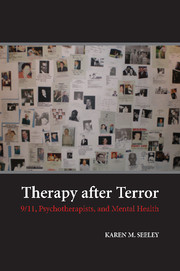Book contents
- Frontmatter
- Contents
- Acknowledgments
- Introduction
- 1 Trauma Histories
- 2 Volunteers for America
- 3 “Get Me Counselors!”
- 4 The Psychological Treatment of Trauma
- 5 The Trauma of Psychological Treatment
- 6 Diagnosing Posttraumatic Stress Disorder
- 7 Trauma as Metaphor
- 8 Mental Health in Traumatic Times
- Notes
- Works Cited
- Index
4 - The Psychological Treatment of Trauma
Published online by Cambridge University Press: 05 August 2012
- Frontmatter
- Contents
- Acknowledgments
- Introduction
- 1 Trauma Histories
- 2 Volunteers for America
- 3 “Get Me Counselors!”
- 4 The Psychological Treatment of Trauma
- 5 The Trauma of Psychological Treatment
- 6 Diagnosing Posttraumatic Stress Disorder
- 7 Trauma as Metaphor
- 8 Mental Health in Traumatic Times
- Notes
- Works Cited
- Index
Summary
Like their colleagues who confronted extraordinary demands when they volunteered after the attack, New York City mental health professionals who worked in private practices, or in hospitals, social service agencies, or educational institutions, faced substantial clinical challenges following the events of 9/11. No matter how extensive their experience, many were taken aback by the ways this unexpected act of mass violence penetrated individuals' bodies and disrupted the workings of their minds. Without the formal training that might have helped prepare them for patients' widely variant reactions, many therapists turned to the clinical literature for direction. Yet they found it largely silent on topics of urgent importance. Because this literature did not adequately address the treatment of patients who were abruptly bereaved by a terrorist attack, whose grief was compounded by trauma, whose losses could be counted in the dozens, who had to mourn in the public eye, or whose suffering seemed interminable, there was little for therapists to draw on as they embarked on the most difficult work of their professional careers.
Mental health professionals who were involved in the immediate disaster response frequently were impressed by the unconventional, and sometimes nonverbal, therapeutic interventions that were delivered after the attack. One thought that the most effective relief workers were those “giving out the cookies and the coffee,” because “they're the ones who are truly touching people. They create an environment where people will talk.”
- Type
- Chapter
- Information
- Therapy after Terror9/11, Psychotherapists, and Mental Health, pp. 80 - 100Publisher: Cambridge University PressPrint publication year: 2008



